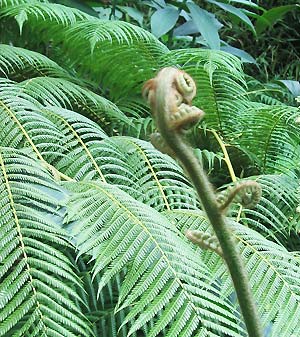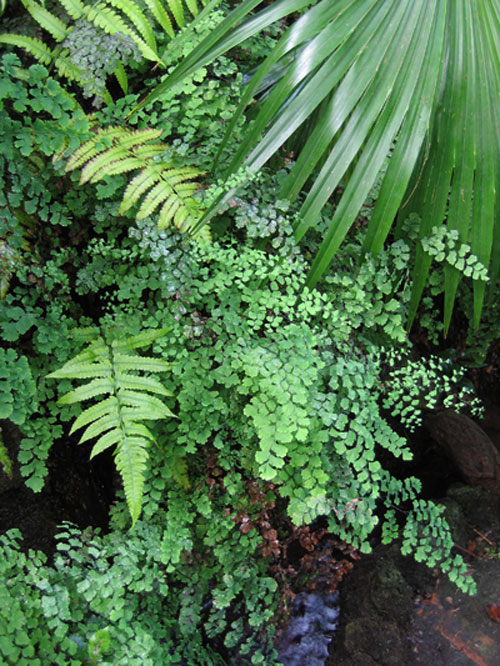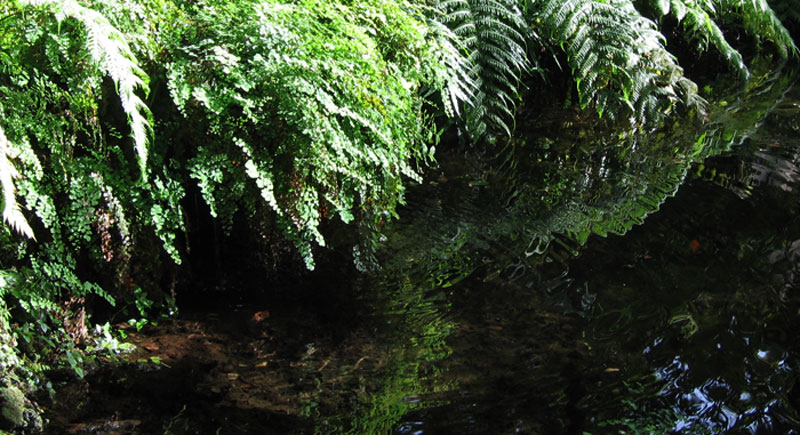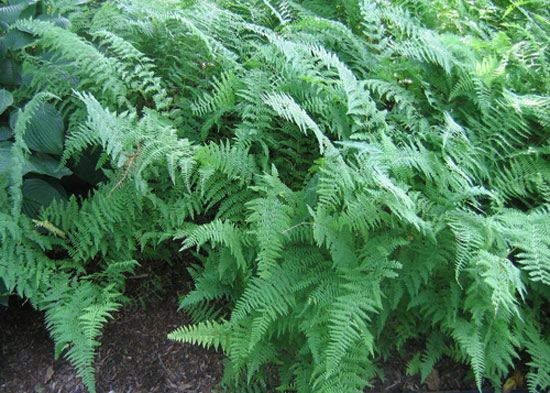| GreenGardeningCookingCuring.com | FERNS
PAGE |
| Tour Our Destination Websites | Taxco-Today.com | Oaxaca-Today.com | Montserrat-Today Site |
| See our silver designs at Krika.com | Read our travel stories and other tales at Krika.com |
|
|
FERNS Ferns are some of my very favorite plants. Their shapes, sizes, colors, textures and often real delicacy have always intrigued me. Below are two photographs I took while enthralled in the fern garden of the Orto Botanico or Botanical Garden in Naples, Italy in 2012, 2013 and 2014. |
||
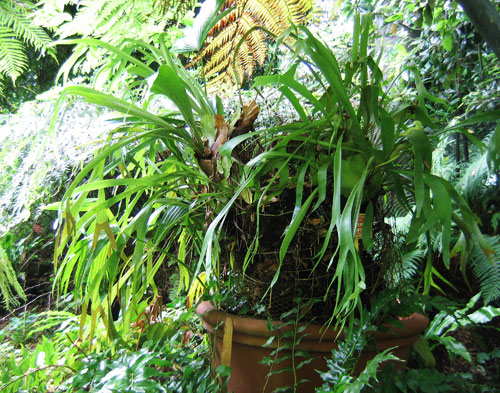  |
||
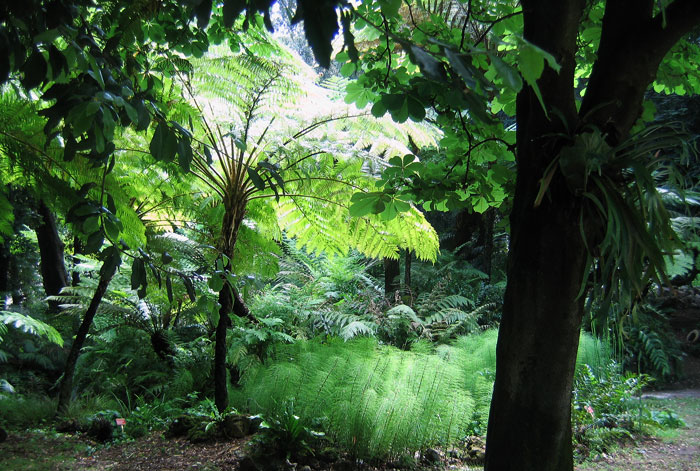 |
||
| Bird's
Nest Fern Asplenium
nidus and syn. Asplenium antiquum, Asplenium australiasicum,
Asplenium filicifolium, Asplenium pachyphyllum These are one of my very favorite ferns. At our former home in Montserrat, I was given a tiny one, but we sold the home and garden not long after so I never did feel like I had made a new fern relationship. There are many varieties of this plant with fronds that are medium sized to large as you can see in the photographs below. Benefits: The bird's nest fern has been used as a curative in folk medicine for a variety of ailments. From: Pacific tropical areas in Asia and to islands in that area like Australia and all the way to Hawaii. Planting and Care: Asplenium nidus thrives in warm, humid areas in partial to full shade. It is not comfortable when temperatures fall below 50° F. Text and Photographs ©GreenGardeningCookingCuring.com 2013/2018 |
||
  To
the left the Bird's Nest Fern with Spores was Photographed: In
Parque de la Leyendas, Lima, Peru, in 2013. The fern to the
right was photographed in the Royal Botanical Garden in Sydney,
Australia in 2013. To
the left the Bird's Nest Fern with Spores was Photographed: In
Parque de la Leyendas, Lima, Peru, in 2013. The fern to the
right was photographed in the Royal Botanical Garden in Sydney,
Australia in 2013. |
||
Photographed: At
the Roger Williams Park Botanical Center in Rhode Island in 2013. |
||
With my gratitude, my fern mystery #2 was identified by Amy, a visitor to the site. |
||
| Boston Fern -- Please see Sword Fern below on this page | ||
This beautiful fern was identified by Pat B. a very helpful visitor to my website. Thanks Pat. |
||
 Chilean
Hard Fern, Seersucker Fern, South American Seersucker Blechnum
chilense syn. B. cordatum, B. magellanicum Chilean
Hard Fern, Seersucker Fern, South American Seersucker Blechnum
chilense syn. B. cordatum, B. magellanicumThis beauty can have fronds 5 feet long. It is said to be a plant that will grow reasonably well in poor conditions, but when given the best it is a stellar performer. Benefits: I have yet to find any medicinal or dietary benefits, but it is an especially beautiful fern. From: Native primarily to Chile, but also found in Argentina Photographed: In the Winter Garden in Auckland, New Zealand, in 2013 Planting and Care: Growing well in semi-shade or full shade, this fern is hardy in frost conditions and even freezing conditions. As with most ferns it prefers a rich, loamy, moist and well drained soil and humidity. In its case, a slightly acidic soil is more desirable. Text and Photograph ©GreenGardeningCookingCuring.com 2014/2019
|
||
 Chinese
Brake, Chinese Ladder Brake, Ladder Fern Pteris
vittata Chinese
Brake, Chinese Ladder Brake, Ladder Fern Pteris
vittataThis beauty needs some room to show itself off and that it does. Benefits: This is a very environmentally advantageous plant as it absorbs arsenic from tainted soil. It is even called a "hyperacumulator." From: Tropical areas of Asia, Africa and Australia Photographed: In Parque de la Leyendas, Lima, Peru, in 2013. Planting and Care: Chinese brake favors moist well-drained soil that has a limestone base and it prefers growing in shade. Text and Photograph ©GreenGardeningCookingCuring.com 2014/2018 |
||
 Crested
Wood Fern, Crested Buckler-Fern, Narrow Swamp Fern Dryopteris
cristata Crested
Wood Fern, Crested Buckler-Fern, Narrow Swamp Fern Dryopteris
cristataBenefits: This is a a good choice for folks having problems with deer in their gardens as deer don't seem to like it. It also has medicinal benefits which seems unusual in a fern. From: North American wetlands Photographed: Coastal Maine Botanical Gardens, Boothbay Maine, 2013. Planting and Care: This is an evergreen fern that will grow to be anywhere from 1 to 3 feet in height. It prefers to be settled into a shady garden where the soil is moist year round. Text and Photograph ©GreenGardeningCookingCuring.com 2013/2019 |
||
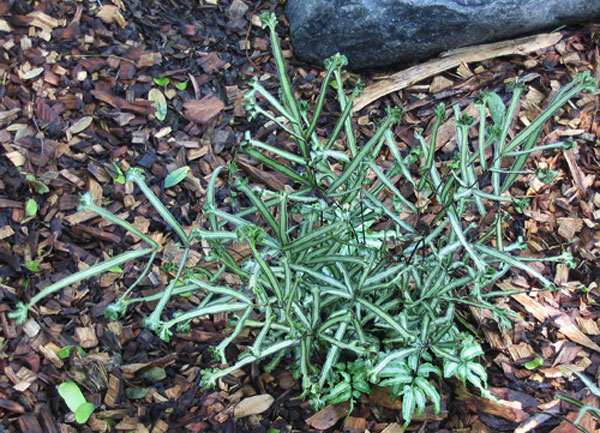 Cretan
Brake Fern, Table Fern, Ribbon Fern Pteris cretica Cretan
Brake Fern, Table Fern, Ribbon Fern Pteris creticaThis is the perfect small fern to brighten up a shady area of your garden. Benefits: From: Europe, Asia and Africa Photographed: In Parque de la Leyendas, Lima, Peru, in 2013. Planting and Care: This is a sub tropical fern so it will not handle freezing temperatures. It will grow to be about 1 to 2 feet wide and tall. It likes bright light and a slightly alkaline well-drained soil. Text and Photograph ©GreenGardeningCookingCuring.com 2014/2019 |
||
| **Deer's
Foot Fern Davallia
family This is one of my favorite ferns and I seem destined to have one. I got my first while living in New England so it occupied most of one of my large sunny windows. And, many years later while driving on one of the very narrow old roads in the north of Montserrat, there they were hanging from the moist shady wild side of the mountain. I confess to stopping the car and adopting one. It is now living well in our shady terraced garden as you can see in the photograph to the left below. Benefits: From: Fiji Photographed: Below on the left in our shady terrace garden at our former home in Montserrat. Below on the right in Parque de la Leyendas, Lima, Peru, in 2013. Planting and Care: These ferns make excellent easy to care for houseplants that will give an exotic air to any room, but keep in mind that the fronds from a hanging pot can be more than a yard long. Give them bright light and regular watering when the soil feels dry and they will be just fine. Outdoors they do well in just the same situation. Text and Photographs ©Krika.com 2008 and GreenGardeningCookingCuring.com 2019 |
||
 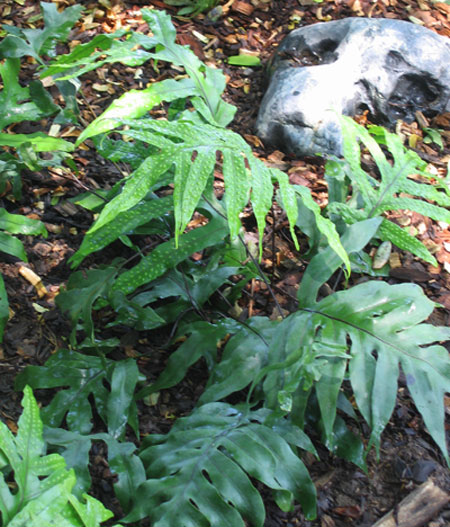 |
||
 Dwarf
Tree Fern, Silver Lady Blechnum gibbum Dwarf
Tree Fern, Silver Lady Blechnum gibbumThe silver lady is a fast grower and will reach its normal mature height of 5 or 6 feet in no time at all. It appearance it is much like a tree fern, but of a size that makes it more adaptable in smaller gardens. Benefits: I didn't find any information on this yet. From: Fiji Photographed: In the Botanic Garden in Wellington, New Zealand, 2013 Planting and Care: This fern is intolerant of frost and seems to be pretty picky about water. Too little or too much will have very unhappy results. It is also intolerant of lime so you will need to acidify its water with a little lemon juice. In tropical or warm climates, plant it in the shade in moist well-drained slightly acidic soil with lots of organic material. Text and Photograph ©GreenGardeningCookingCuring.com 2013/2019 |
||
| Emerald Fern See Below -- Fox Tail Fern | ||
  **Fish
Tail Fern, Fish Tail Sword Fern, Weeping Sword Fern Nephrolepis
falcata furcans, syn's Nephrolepis biserrata
var. furcans, Nephrolepis gibbosum, Nephrolepis
gibbosa, Nephrolepis biserratum var. furcans, Nephrolepis biserrata
'Furcans', Nephrolepis falcata, Nephrolepis biserrata var. furcans,
Nephrolepis falcata f. furcans **Fish
Tail Fern, Fish Tail Sword Fern, Weeping Sword Fern Nephrolepis
falcata furcans, syn's Nephrolepis biserrata
var. furcans, Nephrolepis gibbosum, Nephrolepis
gibbosa, Nephrolepis biserratum var. furcans, Nephrolepis biserrata
'Furcans', Nephrolepis falcata, Nephrolepis biserrata var. furcans,
Nephrolepis falcata f. furcansThis is one of my all time favorite ferns. Its color is wonderful and as you can see in the photographs it has an exuberant amount of fronds when it is happy. Under the right conditions it spreads rapidly, enough so I had to routinely pull plants to give to neighbors or we would have been overrun. Benefits: I didn't find anything yet. From: Myanmar, Vietnam, Philippines, Indonesia, New Guinea Photographed: In our shady terrace garden at our former home in Montserrat. Planting and Care: The tropical fish tail is not particularly fond of mid-day Caribbean sun, though morning or afternoon sun is tolerated pretty well. It is most fond of bright sun-free spaces. It also loves a bit of water as do almost all ferns, but it survived the 2007 months long heat wave and drought in Montserrat while we were away. Text & Photographs ©KO 2007/2010 and GreenGardeningCookingCuring.com 2019 |
||
 **Fish-Tail
Fern (2), Fishtail Strap Fern, Climbing Bird's Nest Fern, Terrestrial
Elkhorn Fern, Crested Fern, Fishtail Strap Fern, Climbing Bird's
Nest Fern, Dwarf Elkhorn Fern Polypodium punctatum 'Grandiceps' **Fish-Tail
Fern (2), Fishtail Strap Fern, Climbing Bird's Nest Fern, Terrestrial
Elkhorn Fern, Crested Fern, Fishtail Strap Fern, Climbing Bird's
Nest Fern, Dwarf Elkhorn Fern Polypodium punctatum 'Grandiceps'For years I was calling this a "lettuce fern" in my inimitable way of casually naming things. There was one growing in the garden in Montserrat when we moved into our new home there and I had no idea what it was. At that time, here is what I wrote, "Lettuce Fern: Lost to the volcanic eruption 7/03. This is a peculiar fern looking like an underwater plant. It has a very delicate appearance, but the leaves are quite tough." Much later I wrote this. "We later had two large and thriving elkhorns living in our shady terraced garden. Elkhorns like to be planted in a relatively protected environment and when happy each plant will be three feet high and three feet wide. My off the cuff remarks about the first plant we had were not far off the mark; elkhorns really do look like underwater plants." Benefits: I haven't yet found any. From: Australia Photographed: In our shady terrace garden at our former home in Montserrat. Planting and Care: Fish-Tail ferns, like many other ferns, prefer a bright shady place in the garden where there is good soil and moisture. It will do well in mildly acidic or alkaline soils. I've grown it in the Caribbean in relatively deep shade and in very bright shade in the Guatemalan highlands. In each place this fern has done well. Sadly, it is a relatively slow grower. Text and Photograph ©Krika.com 2008 and GreenGardeningCookingCuring.com 2013/2014/2019 |
||
  Fox
Tail Fern, Emerald Fern, Sprenger's Asparagus Fern Protasparagus
densiflorus Kunth, syn. Asparagus
densiflorus Jessop, Asparagopsis densiflora Kunth; Protasparagus
densiflorus (Kunth) Oberm. Fox
Tail Fern, Emerald Fern, Sprenger's Asparagus Fern Protasparagus
densiflorus Kunth, syn. Asparagus
densiflorus Jessop, Asparagopsis densiflora Kunth; Protasparagus
densiflorus (Kunth) Oberm.Not until I saw this fern growing in Rhode Island did I really see its potential. It makes a splendid ground cover underneath sizeable trees where lower growing ground covers would be dwarfed. Benefits: From: Temperate areas of Southern Africa Photographed: At the Hotel Atitlan on Lake Atitlan in Guatemala in 2010 unless otherwise noted. Planting and Care: This is one of those wonderfully hardy ferns that can handle life in full sun though it will also do fine in semi shady areas of the garden. Almost unbelievably it is also tolerant of its access to water, doing fine with routine rainfall or watering, but putting up with less if it has to. Text & Photographs ©KO 2010 and GreenGardeningCookingCuring.com 2014/2019 |
||
  Photographed: To
the left in a city street garden in Malaga, Spain, in 2012. On
the right at
the Roger Williams Park Botanical Center in Rhode Island
in 2013. Photographed: To
the left in a city street garden in Malaga, Spain, in 2012. On
the right at
the Roger Williams Park Botanical Center in Rhode Island
in 2013. |
||
 Hay
Scented Fern, Eastern Hayscented Fern Dennstaedtia
punctilobula Hay
Scented Fern, Eastern Hayscented Fern Dennstaedtia
punctilobulaThis hardy fern produces a fresh mown hay scent when its leaves are brushed by a hand, hence its name. Benefits: This is one plant deer don't like to eat. From: Eastern North America as far north as New-Found-Land, south to northern Alabama and west to Arkansas and Wisconsin Photographed: In the Thuya Garden, Mt. Desert Island, Maine, 2013. Planting and Care: It prefers damp acidic soils in woods or fields. With some attention given, this fern will be very pleasing as you can see in the photograph. It prefers shade or shade with morning or late afternoon sun. It is tolerant of almost any soil and in most areas it will probably do well with rainfall or occasional watering. This could make an excellent ground cover as it grows only to about 2 feet in height. Mix in some wildflower seeds and it will be just lovely. Text and Photograph ©GreenGardeningCookingCuring.com 2013/2019 |
||
 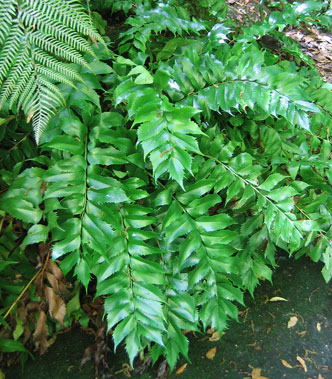 **Holly
Fern, Japanese Holly Fern Cyrtomium
falcatum **Holly
Fern, Japanese Holly Fern Cyrtomium
falcatumI had one of these as a houseplant in Washington, DC, where I lived for several years. It never disappointed me in any way; it was always green and healthy. For a fern it is especially tough looking with thick leathery leaves. I was thrilled to see one growing outside. Benefits: I haven't read anything about the holly fern, except for its appealing attributes in the garden. From: Asia, India, southern Africa and Hawaii Photographed: In the Botanical Garden at Hotel Atitlan on Lake Atitlan in Guatemala on the left. On the right in the fern garden at the Naples, Italy, Botanical Garden. Planting and Care: As with all ferns it is most practical to buy plants or get some from friends. Sometimes you'll be lucky and have a volunteer if there are some in your neighborhood. Plant them in a shady place, even in deep shade, and make sure they don't get too dry. When mature, the fronds will reach up to 2 feet in length. Text & Photographs ©GreenGardeningCookingCuring.com 2014/2019 |
||
With my appreciation, my error in identification of these ferns was corrected by a visitor to the site, Sharon from Denver, Colorado, in the USA, Many thanks, Kathleen |
||
  |
||
With
my appreciation, my Mystery Fern #6 was identified by a valued
visitor to the site, Sharon from Denver, Colorado, in the
USA. |
||
Leather
Leaf Fern, Leather Fern, Leathery Shieldfern, Iron Fern,
7-Weeks-Fern, Climbing Shield Fern, Rumohra
(polystichum) adiantiformis |
||

Lime
Fern, Gully Fern, Feather Fern Pneumatopteris
pennigera With my appreciation, this mystery was tentatively by Peter from Auckland, New Zealand. Thanks, Peter. |
||
 Long
Brake, Elephantleaf Brake Pteris grandifolia Long
Brake, Elephantleaf Brake Pteris grandifoliaThis is a beautiful fern which will be exuberant given the right conditions. When mature its fronds can reach lengths of from about 3 feet to 15 feet. Benefits: I haven't found anything yet. From: Subtropical and tropical areas of the world. Photographed: In Parque de la Leyendas, Lima, Peru, in 2013. Planting and Care: As you can see in the photographs, long brake can handle some very hot sun. It likes to grow on moist rocky slopes. Note: I found very little information on this fern which is disappointing as it is stunning. If you have any information on it, I'd love to hear from you. Text and Photograph ©GreenGardeningCookingCuring.com 2014/2019 |
||
 |
||
 Double-Edge
Maidenhair, Walking Fern Adiantum anceps Double-Edge
Maidenhair, Walking Fern Adiantum ancepsThis is a beautiful warm climate fern with delicate, graceful fronds. I would like one in my garden. Benefits: Maidenhair ferns have been used in traditional medicine for a variety of ailments. From: Bolivia, Colombia, Ecuador, Peru Photographed: To the right In the Royal Botanic Garden in Sydney, Australia, in 2013 and below in the Jardin Botanique in Tahiti, also in 2013. Planting and Care: This enchanting plant will grow to be about 2 feet tall. I think it is best planted in a bright shady area of the garden where soil moisture is guaranteed as it never thrives without it. Planting it by a water garden would give it just the environment it loves. Adiantum anceps is a warm climate fern so in cold areas, treat it as a valued house plant. Text and Photographs ©GreenGardeningCookingCuring.com 2015/2019 |
||
|
||
| **Delta
Maidenhair Fern, Maidenhair Fern, Pacific Maidenhair Adiantum
raddianum In New England I always had a pot of these lovely ferns growing happily on a bright northerly facing window ledge. What was so delightful in the Caribbean was seeing this delicate plant growing happily along the roadside. They are said to be difficult to transplant successfully, but I did not find that to be so. Benefits: This delicate fern has been used in traditional medicine as a curative for coughs and congestion in the chest. It can also be used to darken hair and to delay or prevent hair loss. From: The Caribbean and tropical Americas. Photographed: Below on the left in our shady terrace garden at our former home in Montserrat. Below on the right in Parque de la Leyendas, Lima, Peru, in 2013. Planting and Care: This is a delicate warm climate fern that loves bright shade, moist soil and lots of humidity. Text and Photographs ©Krika.com 2008 and ©GreenGardeningCookingCuring.com 2014/2019 |
||
  |
||
|
||
| Ming Fern -- Please see the A Page under Asparagus | ||
 Mother
Fern, Mother Spleenwort, Hen and Chicken fern Asplenium
bulbiferum Mother
Fern, Mother Spleenwort, Hen and Chicken fern Asplenium
bulbiferum This is an evergreen tropical or sub-tropical plant that thrives in New Zealand's waterways. Benefits: Its fronds can be eaten as a vegetable. From: New Zealand Photographed: In northwestern New Zealand Planting and Care: Usually found growing by riversides in New Zealand, this lovely fern prefers to live in full shade in a rich moist soil that isn't water logged, but which is always moist. When mature it will be 4 feet high and 3 feet wide. It is not frost tolerant. Text and Photograph ©GreenGardeningCookingCuring.com 2018/2019 |
||
 **Rabbits
Foot Fern Davallia
fejeensis **Rabbits
Foot Fern Davallia
fejeensisThis is one of my long term favorites -- a large wide lacy fern frond growing on a furry foot. Benefits: These ferns are used in traditional medicine to cure or alleviate fairly serious illnesses. The rabbit foot ferns are non-toxic to pets. From: Fiji Photographed: To the right in the Royal Botanic Garden in Sydney, Australia, in 2013. Planting and Care: This is one of those ferns that grows on a thick (1/2") stem that grows on the ground when they are in their natural tropical habitat. In more northerly climates, it is an indoor plant almost always potted as a hanging plant with the feet growing over the edge of the pot until it is almost covered. Often they are planted in wire baskets to be hung on terraces in the summer, but these are hard to care for when brought inside in the fall. They will not winter over outside in a northern climate. In our Caribbean garden we planted ours in our shady terrace garden where it did very well. It proved pretty hardy, having survived a four month drought while we were away one year. Text and Photographs ©Krika.com 2008 and GreenGardeningCookingCuring.com 2014/2019 |
||
|
||
 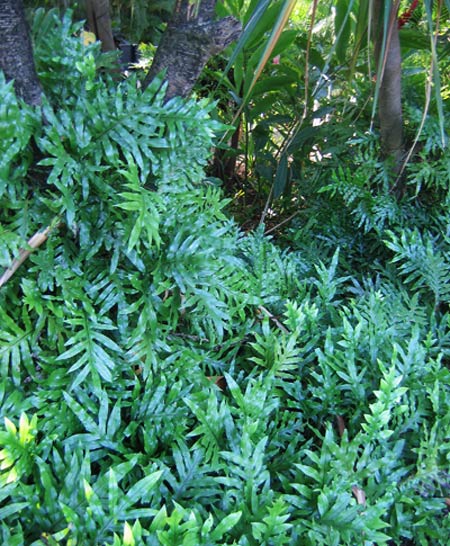 **Squirrel's
Foot Fern, Ball Fern Davillia mariesii **Squirrel's
Foot Fern, Ball Fern Davillia mariesiiThis was a wonderful and unfamiliar addition to our "footed" fern garden at our former home in Montserrat and it brought its own wonderfully different characteristics to the others. Its fronds are attractive, but relatively short, only about a foot in length. Overall the plant seems extremely hardy having been off and running just a few days after being planted. Benefits: In traditional medicine the squirrel's foot fern has been used to improve kidney function, to promote vitality and sexual energy. From: Japan and eastern Asia Photographed: Below on the left in our shady terrace garden at our former home in Montserrat and on the right in Cartagena, Columbia. Planting and Care: Grow this fern in a semi shady or a deeply shaded area of your garden and it will thrive. As with most ferns, a rich moist but not wet soil will be appreciated. Text and Photographs ©Krika.com 2008 and ©GreenGardeningCookingCuring.com 2013/2019 |
||
  **Elk
Horn Fern (1) Platycerium superbum **Elk
Horn Fern (1) Platycerium superbumThis is a very exotic looking fern that attaches itself to and grows on trees. We were given one a few years ago and planted it in the perfect spot on the neem tree in our shady terraced hill garden. It had three tiny leaves back then and though we tended it carefully, it didn't die, but it never grew. Then one day my husband had an epiphany -- nothing will grow on a neem tree. We moved the fern to a different tree and it was growing happily adding new leaves each week. Benefits: Other than the beauty I didn't find any health or other types of benefits. From: Australia Photographed: On the left in our shady terrace garden at our former home in Montserrat and on the right at a friend's home also on the island. Planting and Care: If you are lucky enough to get one of these ferns, find a bright semi shady tree (not a neem) and attach your plant to the tree with cotton twine or with two inch torn strips of cotton cloth. Give the tiny fern a daily dose of water and a weekly dose of a liquid fertilizer. You will be as thrilled as I am every time you see a tiny new leaf and a flat round circular green attachment to the tree. Text and Photographs ©Krika.com 2008 and ©GreenGardeningCookingCuring.com 2019 |
||
This
Fern Mystery was solved with the help of a new visitor to the
site, Sharon from Denver, Colorado |
||
Photographed: At
the Botanic Garden in Sydney, Australia, in
2013.  |
||
 Port
Jackson Stag Horn Fern Platycerium
Alcicoine Madagascar Port
Jackson Stag Horn Fern Platycerium
Alcicoine MadagascarThese epiphytic ferns "usually grow on the trunks of rainforest trees, their roots absorbing water and nutrients from the forest above. They trap debris in the shield (sterile frond) that forms the back, and the "staghorns", or fertile fronds produce the spores with which they reproduce." This narrow leaved stag horn has few entries in Google and the photos for this entry are mostly totally unrelated flowers. It's a shame because it is an interesting plant and I would have liked to learn more. Benefits: It is non-toxic to household pets. From: As the name of this wonderful fern implies it is from Madagascar, the Seychelles and Comoros Islands, as well as Mozambique and Zimbabwe. Photographed: In the Botanical Garden in Naples, Italy, in 2014. Planting and Care: Port Jackson Stag Horn Ferns are not very accommodating of cold temperatures, though they are tougher than some other ferns in this group. Attach it to a tree in the shade with cotton twine or cloth. Water it regularly when it dries and cross your fingers. It is a lovely fern, but unusual and probably a little difficult to please. Keep in mind that its natural environment is in rainforests where the air itself is humid. Text and Photograph ©GreenGardeningCookingCuring.com 2015/2019 |
||
 If
You Know What This Fern Is, Please Contact Me If
You Know What This Fern Is, Please Contact MeStaghorn Fern Mystery Photographed: At the Botanic Garden in Sydney, Australia, in 2013. Photograph ©GreenGardeningCookingCuring.com 2014 |
||
|
||
|
||
Photographed: Each of these photographs was taken In the Botanical Garden at the Hotel Atitlan on Lake Atitlan in Guatemala.
|
||
 Photographed: In the Ortobotanico (Botanical
Garden) in Naples, Italy, in 2014 Photographed: In the Ortobotanico (Botanical
Garden) in Naples, Italy, in 2014 |
||
Soften the base of a fence, wall or foundation with a row of ferns.
|
||
Create
the feeling of a tropical forest with an abundance of different
ferns and small palms.
|
||
Create
a very beneficial feng shui water feature embedded in a fern garden.
|
||
Shelter
a small reflecting koi pond with overhanging ferns.
|
||
Never
forget the benefits of layering ferns especially those with similarly
shaped fronds. |
||
|
||
|
||
|
||
|
||
|
||
If
You Know What This Fern Is, Please Contact Me #12 Fern Mystery Photographed: In our shady terrace garden at our former home in Montserrat. Text & Photograph ©KO 2009  |
||
| If
You Know What This Fern Is, Please Contact Me Mystery Fern 13a and 13b I dubbed the 'Tattoo Fern' Photographed: At a friend's home in Woodlands, Montserrat. This lovely lacey fern showed up in our garden one year all on its own and it seemed to have found its own sort of eden as it flourished and spread rapidly. One afternoon visiting a friend in her garden I was told of this fern's local life. For the children of Montserrat in days gone by this fern provided free, instant and very decorative tattoos as you can see in the photograph below on the right. Planting and Care: As this fern was a volunteer in a sunny place in our garden I'd have to say it would do well there, but it would have to be given regular rainfall or watering to be at its best. It is a much more delicate plant than the sword fern or many of the other long fronded varieties we have in the garden. Text & Photographs ©Krika.com 2008 and ©GreenGardeningCookingCuring.com 2019 |
||
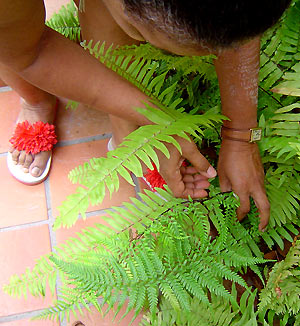  |
||
|
||
If
You Know What This Fern Is, Please Contact Me
|
||
If
You Know What This Fern Is, Please Contact Me
|
||
|




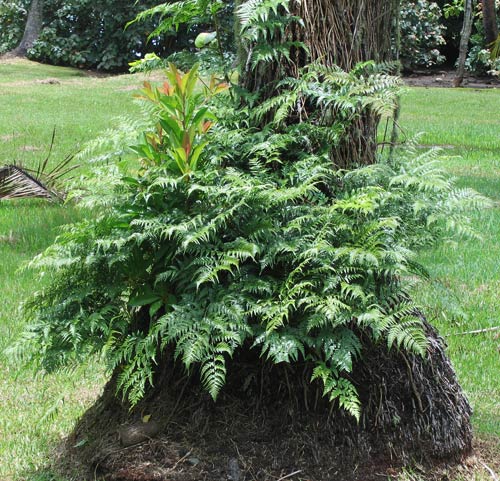

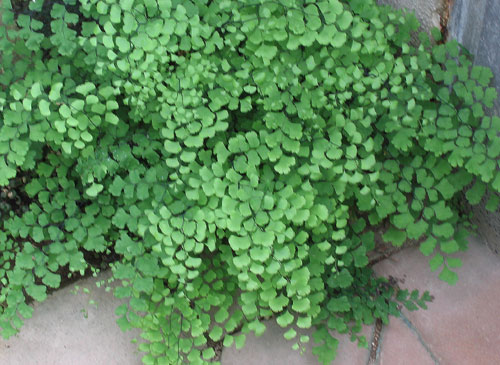
 Photographed: In
the Botanical Garden in Naples, Italy, in 2012.
Photographed: In
the Botanical Garden in Naples, Italy, in 2012. 

 Stag
Horn Fern (2) Platycerium holttumii
Stag
Horn Fern (2) Platycerium holttumii

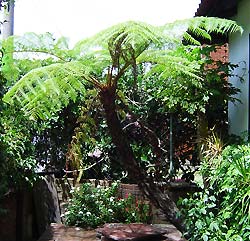 **Tree
Fern, West Indian Tree Fern Cyathea
arborea (L.) J. E. Smith
**Tree
Fern, West Indian Tree Fern Cyathea
arborea (L.) J. E. Smith